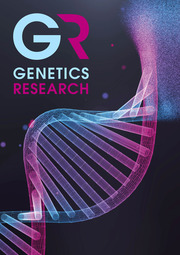Crossref Citations
This article has been cited by the following publications. This list is generated based on data provided by
Crossref.
Garnier‐Géré, Pauline Hélène
Naciri‐Graven, Yamama
Bougrier, Serge
Magoulas, Antonios
Héral, Maurice
Kotoulas, Georgios
Hawkins, Anthony
and
Gérard, André
2002.
Influences of triploidy, parentage and genetic diversity on growth of the Pacific oysterCrassostrea gigasreared in contrasting natural environments.
Molecular Ecology,
Vol. 11,
Issue. 8,
p.
1499.
Amiard, J.-C.
Perrein-Ettajani, H.
Gérard, A.
Baud, J. P.
and
Amiard-Triquet, C.
2004.
Influence of Ploidy and Metal–Metal Interactions on the Accumulation of Ag, Cd, and Cu in Oysters Crassostrea Gigas Thunberg.
Archives of Environmental Contamination and Toxicology,
Vol. 48,
Issue. 1,
p.
68.
Vadopalas, Brent
and
Davis, Jonathan P.
2004.
Optimal chemical triploid induction in geoduck clams, Panopea abrupta, by 6-dimethylaminopurine.
Aquaculture,
Vol. 230,
Issue. 1-4,
p.
29.
Hand, R.E
Nell, J.A
and
Thompson, P.A
2004.
Studies on triploid oysters in Australia.
Aquaculture,
Vol. 233,
Issue. 1-4,
p.
93.
Mallia, Jyothi V
Muthiah, Palaniyappan
and
Thomas, Palahani C
2006.
Growth of triploid oyster, Crassostrea madrasensis (Preston).
Aquaculture Research,
Vol. 37,
Issue. 7,
p.
718.
Marie, Véronique
Gonzalez, Patrice
Baudrimont, Magalie
Boutet, Isabelle
Moraga, Dario
Bourdineaud, Jean‐Paul
and
Boudou, Alain
2006.
Metallothionein gene expression and protein levels in triploid and diploid oysters Crassostrea gigas after exposure to cadmium and zinc.
Environmental Toxicology and Chemistry,
Vol. 25,
Issue. 2,
p.
412.
Gagnaire, Beatrice
Soletchnik, Patrick
Madec, Patrick
Geairon, Philippe
Le Moine, Olivier
and
Renault, Tristan
2006.
Diploid and triploid Pacific oysters, Crassostrea gigas (Thunberg), reared at two heights above sediment in Marennes-Oleron Basin, France: Difference in mortality, sexual maturation and hemocyte parameters.
Aquaculture,
Vol. 254,
Issue. 1-4,
p.
606.
Garner, S. R.
Madison, B. N.
Bernier, N. J.
and
Neff, B. D.
2008.
Juvenile growth and aggression in diploid and triploid Chinook salmon Oncorhynchus tshawytscha (Walbaum).
Journal of Fish Biology,
Vol. 73,
Issue. 1,
p.
169.
Normand, Julien
Le Pennec, Marcel
and
Boudry, Pierre
2008.
Comparative histological study of gametogenesis in diploid and triploid Pacific oysters (Crassostrea gigas) reared in an estuarine farming site in France during the 2003 heatwave.
Aquaculture,
Vol. 282,
Issue. 1-4,
p.
124.
Bayne, B.L.
2009.
Carbon and nitrogen relationships in the feeding and growth of the Pacific oyster, Crassostrea gigas (Thunberg).
Journal of Experimental Marine Biology and Ecology,
Vol. 374,
Issue. 1,
p.
19.
Nichols, Krista M.
2009.
Molecular Research in Aquaculture.
p.
195.
Ginn, Brian R.
2010.
The implications of gene heterozygosity for protein folding and protein turnover.
Journal of Theoretical Biology,
Vol. 265,
Issue. 4,
p.
554.
Jouaux, A.
Heude-Berthelin, C.
Sourdaine, P.
Mathieu, M.
and
Kellner, K.
2010.
Gametogenic stages in triploid oysters Crassostrea gigas: Irregular locking of gonial proliferation and subsequent reproductive effort.
Journal of Experimental Marine Biology and Ecology,
Vol. 395,
Issue. 1-2,
p.
162.
De Decker, S.
Normand, J.
Saulnier, D.
Pernet, F.
Castagnet, S.
and
Boudry, P.
2011.
Responses of diploid and triploid Pacific oysters Crassostrea gigas to Vibrio infection in relation to their reproductive status.
Journal of Invertebrate Pathology,
Vol. 106,
Issue. 2,
p.
179.
Dégremont, Lionel
Garcia, Céline
Frank-Lawale, Anu
and
Allen, Standish K.
2012.
Triploid Oysters in the Chesapeake Bay: Comparison of Diploid and TriploidCrassostrea virginica.
Journal of Shellfish Research,
Vol. 31,
Issue. 1,
p.
21.
Walton, W.C.
Rikard, F.S.
Chaplin, G.I.
Davis, J.E.
Arias, C.R.
and
Supan, J.E.
2013.
Effects of ploidy and gear on the performance of cultured oysters, Crassostrea virginica: Survival, growth, shape, condition index and Vibrio abundances.
Aquaculture,
Vol. 414-415,
Issue. ,
p.
260.
2013.
Evaluating the Potential Growth Advantage of Triploid Eastern Oysters (Crassostrea virginica) in South Carolina Relative to Commercially Cultured Diploid Native Stocks.
Journal of Shellfish Research,
Vol. 32,
Issue. 3,
p.
647.
Hawkins, A. J. S.
Pascoe, P. L.
Parry, H.
Brinsley, M.
Black, K. D.
McGonigle, C.
Moore, H.
Newell, C. R.
O'Boyle, N.
Ocarroll, T.
O'Loan, B.
Service, M.
Smaal, A. C.
Zhang, X. L.
and
Zhu, M. Y.
2013.
Shellsim: A Generic Model of Growth and Environmental Effects Validated Across Contrasting Habitats in Bivalve Shellfish.
Journal of Shellfish Research,
Vol. 32,
Issue. 2,
p.
237.
2015.
Marine Bivalve Molluscs.
p.
383.
Dégremont, Lionel
Garcia, Céline
and
Allen, Standish K.
2015.
Genetic improvement for disease resistance in oysters: A review.
Journal of Invertebrate Pathology,
Vol. 131,
Issue. ,
p.
226.


